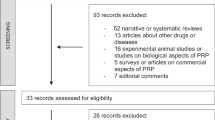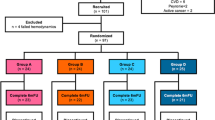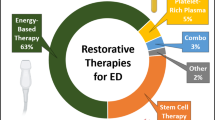Abstract
Erectile dysfunction (ED) is defined as the inability to attain and maintain erection of the penis sufficient to permit satisfactory sexual activity. ED most commonly affects men from 40 years of age with a clear age-associated increase in prevalence. The condition may have significant negative impact on quality of life for both the patients and their partners. Over recent years, low-intensity shockwave therapy (LIST) has gained popularity in the treatment of ED, based on the assumption that LIST application may result in neoangiogenesis and thus increased blood flow to the corpora cavernosa. The increasing usage of LIST is contrasting with current guidelines, with the EAU guideline on ED stating that LIST can be used in mild organic ED patients or poor responders to PDE5I’s, but with a weak strength of recommendation. In the AUA guideline on ED, the panel makes a conditional recommendation of grade C that LIST should be considered investigational. In this review, we will briefly review practice patterns, and critically discuss the evidence based on which these guideline statements have been made.
This is a preview of subscription content, access via your institution
Access options
Subscribe to this journal
Receive 8 print issues and online access
$259.00 per year
only $32.38 per issue
Buy this article
- Purchase on Springer Link
- Instant access to full article PDF
Prices may be subject to local taxes which are calculated during checkout
Similar content being viewed by others
References
NIH Consensus Conference. NIH Consensus Conference. Impotence. NIH Consensus Development Panel on Impotence. JAMA. 1993. https://doi.org/10.1001/jama.1993.03510010089036.Text
Braun M, Wassmer G, Klotz T, Reifenrath B, Mathers M, Engelmann U. Epidemiology of erectile dysfunction: results of the ‘Cologne Male Survey’. Int J Impot Res. 2000;12:305–11.
Philippou YA, Jung JH, Steggall MJ, O'Driscoll ST, Bakker CJ, Bodie JA, Dahm P. Penile rehabilitation for postprostatectomy erectile dysfunction. Cochrane Database Syst Rev. 2018;10:CD012414.
Buvat J, Maggi M, Gooren L, Guay AT, Kaufman J, Morgentaler A, Schulman C, et al. Torres LO. Endocrine aspects of male sexual dysfunctions. J Sex Med. 2010;7:1627–56
Jackson G, Montorsi P, Adams MA, Anis T, El-Sakka A, Miner M, et al. Cardiovascular aspects of sexual medicine. 2010;7:1608–26. https://doi.org/10.1111/j.1743-6109.2010.01779.x.
Deveci S, Palese M, Parker M, Guhring P, Mulhall JP. Erectile function profiles in men with Peyronie's disease. J Urol. 2006;175:1807–11
Besiroglu H, Otunctemur A, Ozbek E. The relationship between metabolic syndrome, its components, and erectile dysfunction: a systematic review and a meta-analysis of observational studies. J Sex Med. 2015;12:1309–18. https://doi.org/10.1111/jsm.12885
Shiri R, Koskimäki J, Häkkinen J, et al. Effects of age, comorbidity and lifestyle factors on erectile function: Tampere Ageing Male Urological Study (TAMUS). Eur Urol. 2004;45:628–33. https://doi.org/10.1016/j.eururo.2003.11.020
Sánchez-Cruz JJ, Cabrera-León A, Martín-Morales A, Fernández A, Burgos R, Rejas J. Male erectile dysfunction and health-related quality of life. Eur Urol. 2003;44:245–53. https://doi.org/10.1038/nrd893
Rotella DP. Phosphodiesterase 5 inhibitors: current status and potential applications. Nat Rev Drug Discov. 2002;1:674–82.
Carson CC, Burnett AL, Levine LA, Nehra A. The efficacy of sildenafil citrate (viagra®) in clinical populations: an update. Urology . 2002;60:12–27.
Hatzimouratidis K, Hatzichristou DG. A comparative review of the options for treatment of erectile dysfunction: which treatment for which patient? Drugs. 2005;65:1621–50.
Montorsi F, Verheyden B, Meuleman E, et al. Long-term safety and tolerability of Tadalafil in the treatment of erectile dysfunction. Eur Urol. 2004;45:339–45. https://doi.org/10.1016/j.eururo.2003.11.010
Corona G, Mondaini N, Ungar A, Razzoli E, Rossi A, Fusco F. Phosphodiesterase Type 5 (PDE5) inhibitors in erectile dysfunction: the proper drug for the proper patient. J Sex Med. 2011;8:3418–32. https://doi.org/10.1111/j.1743-6109.2011.02473.x
Hatzimouratidis K, Amar E, Eardley I, et al. Guidelines on male sexual dysfunction: erectile dysfunction and premature ejaculation. Eur Urol. 2010;57:804–14. https://doi.org/10.1016/j.eururo.2010.02.020
Hanson-Divers C, Jackson SE, Lue TF, Crawford SY, Rosen RC. Health outcomes variables important to patients in the treatment of erectile dysfunction. J Urol. 1998;159:1541–7.
Fode M, Hatzichristodoulou G, Serefoglu EC, Verze P, Albersen M. Low-intensity shockwave therapy for erectile dysfunction: Is the evidence strong enough? Nat Rev Urol. 2017;14:593–606. https://doi.org/10.1038/nrurol.2017.119
Vardi Y, Appel B, Jacob G, Massarwi O, Gruenwald I. Can low-intensity extracorporeal shockwave therapy improve erectile function? A 6-month follow-up pilot study in patients with organic erectile dysfunction. Eur Urol. 2010;58:243–8. https://doi.org/10.1016/j.eururo.2010.04.004
Cleveland RO, McAteer JA. Physics of shock-wave lithotripsy. In: Smith’s textbook of endourology Smith's Textbook of Endourology, I&II, 3rd Edition (Arthur D. Smith MD, Gopal H. Badlani MD, Glenn M. Preminger MD, Louis R. Kavoussi MD (eds.)) Blackwell Publishing Ltd, 2012. p. 527–58.
Seidl M, Steinbach P, Wörle K, Hofstädter F. Induction of stress fibres and intercellular gaps in human vascular endothelium by shock-waves. Ultrasonics. 1994;32:397–400. https://doi.org/10.1016/j.eururo.2010.04.004
Apfel R. Acoustic cavitation: a possible consequence of biomedical uses of ultrasound. Br J Cancer Suppl. 1982;5:140–6.
Ciampa AR, De Prati AC, Amelio E, et al. Nitric oxide mediates anti-inflammatory action of extracorporeal shock waves. FEBS Lett. 2005;579:6839–45. https://doi.org/10.1016/j.febslet.2005.11.023
Gotte G, Amelio E, Russo S, Marlinghaus E, Musci G, Suzuki H. Short-time non-enzymatic nitric oxide synthesis from L-arginine and hydrogen peroxide induced by shock waves treatment. FEBS Lett. 2002;520:153–5. https://doi.org/10.1016/S0014-5793(02)02807-7
Gruenwald I, Appel B, Vardi Y. Low-intensity extracorporeal shock wave therapy—a novel effective treatment for erectile dysfunction in severe ED patients who respond poorly to PDE5 inhibitor therapy. J Sex Med. 2012;9:259–64. https://doi.org/10.1111/j.1743-6109.2011.02498.x
Bechara A, Casabé A, De Bonis W, Ciciclia PG. Twelve-month efficacy and safety of low-intensity shockwave therapy for erectile dysfunction in patients who do not respond to phosphodiesterase type 5 inhibitors. Sex Med. 2016;4:e225–e232. https://doi.org/10.1016/j.esxm.2016.06.001
Tsai CC, Wang CJ, Lee YC, et al. Low-intensity extracorporeal shockwave therapy can improve erectile function in patients who failed to respond to phosphodiesterase type 5 inhibitors. Am J Mens Health. 2017;11:1781–90. https://doi.org/10.1177/1557988317721643
Kitrey ND, Gruenwald I, Appel B, Shechter A, Massarwa O, Vardi Y. Penile low intensity shock wave treatment is able to shift PDE5i nonresponders to responders: a double-blind, sham controlled study. J Urol. 2016;195:1550–5. https://doi.org/10.1016/j.juro.2015.12.049
Burnett AL, Nehra A, Breau RH, et al. Erectile dysfunction: AUA guideline. J Urol. 2018;200:633–41. https://doi.org/10.1016/j.juro.2018.05.004
Kalyvianakis D, Memmos E, Mykoniatis I, Kapoteli P, Memmos D, Hatzichristou D. Low-intensity shockwave therapy for erectile dysfunction: a randomized clinical trial comparing 2 treatment protocols and the impact of repeating treatment. J Sex Med. 2018:1–12. https://doi.org/10.1016/j.jsxm.2018.01.003
Reisman Y, Hind A, Varaneckas A, Motil I. Initial experience with linear focused shockwave treatment for erectile dysfunction: a 6-month follow-up pilot study. Int J Impot Res. 2014;27:108–12. https://doi.org/10.1038/ijir.2014.41
Pelayo-Nieto M, Linden-Castro E, Alias-Melgar A, et al. Linear shock wave therapy in the treatment of erectile dysfunction. Actas Urol Esp. 2015;39:456–9. https://doi.org/10.1016/j.acuro.2014.09.010
Hisasue S, China T, Horiuchi A, et al. Impact of aging and comorbidity on the efficacy of low-intensity shock wave therapy for erectile dysfunction. Int J Urol. 2016;23:80–4. https://doi.org/10.1111/iju.12955
Chung E, Cartmill R. Evaluation of clinical efficacy, safety and patient satisfaction rate after low-intensity extracorporeal shockwave therapy for the treatment of male erectile dysfunction: an Australian first open-label single-arm prospective clinical trial. BJU Int. 2015;115(S5):46–9. https://doi.org/10.1111/bju.13035
Ruffo A, Capece M, Prezioso D, et al. Safety and efficacy of low intensity shockwave (LISW) treatment in patients with erectile dysfunction. Int Braz J Urol. 2015;41:967–74. https://doi.org/10.1590/S1677-5538.IBJU.2014.0386
Frey A, Sønksen J, Fode M. Low-intensity extracorporeal shockwave therapy in the treatment of postprostatectomy erectile dysfunction: a pilot study. Scand J Urol. 2016;50:123–7. https://doi.org/10.3109/21681805.2015.1100675
Rosen RC, Allen KR, Ni X, Araujo AB. Minimal clinically important differences in the erectile function domain of the international index of erectile function scale. Eur Urol. 2011;60:1010–6. https://doi.org/10.1016/j.eururo.2011.07.053
Katz JE, Molina ML, Clavijo R, Prakash NS, Ramasamy R. A phase 2 randomized trial to evaluate different dose regimens of low-intensity extracorporeal shockwave therapy for erectile dysfunction: clinical trial update. Eur Urol Focus. 2018;4:336–7. https://doi.org/10.1016/j.euf.2018.07.011
Kitrey ND, Vardi Y, Appel B, et al. Low intensity shock wave treatment for erectile dysfunction—how long does the effect last? J Urol. 2018;200:167–70. https://doi.org/10.1016/j.juro.2018.02.070
Mulhall JP, Carlsson M, Stecher V, Tseng LJ. Predictors of erectile function normalization in men with erectile dysfunction treated with placebo. J Sex Med. 2018;15:866–72. https://doi.org/10.1016/j.jsxm.2018.03.089
de Araujo AC, da Silva FG, Salvi F, Awad MC, da Silva EA, Damião R. The management of erectile dysfunction with placebo only: does it work? J Sex Med. 2009;6. https://www.jsm.jsexmed.org/article/S1743-6095(15)32350-X/fulltext.
Fojecki GL, Tiessen S, Osther PJS. Effect of low-energy linear shockwave therapy on erectile dysfunction—a double-blinded, sham-controlled, randomized clinical trial. J Sex Med. 2016;14:106–12. https://doi.org/10.1016/j.jsxm.2016.11.307
Fojecki GL, Tiessen S, Sloth Osther PJ. Effect of linear low-intensity extracorporeal shockwave therapy for erectile dysfunction-12-month follow-up of a randomized, double-blinded, sham-controlled study. Sex Med. 2018;6:1–7. https://doi.org/10.1016/j.esxm.2017.09.002
Yee C-H, Chan ES, Hou SS-M, Ng C-F. Extracorporeal shockwave therapy in the treatment of erectile dysfunction: a prospective, randomized, double-blinded, placebo controlled study. Int J Urol. 2014;21:1041–5. https://doi.org/10.1111/iju.12506
Olsen AB, Persiani M, Boie S, Hanna M, Lund L. Can low-intensity extracorporeal shockwave therapy improve erectile dysfunction? A prospective, randomized, double-blind, placebo-controlled study. Scand J Urol. 2015;49:329–33. https://doi.org/10.3109/21681805.2014.984326
Motil I, Kubis I, Sramkova T. Treatment of vasculogenic erectile dysfunction with Piezowave 2 device. Application of low intensity shockwaves using novel linear shockwave tissue coverage (LSTC-ED®) technique. A prospective, multicentric, placebo-controlled study. Adv Sex Med. 2016;6:15–8.
Srini VS, Reddy RK, Shultz T, Denes B. Low intensity extracorporeal shockwave therapy for erectile dysfunction: a study in an Indian population. Can J Urol. 2015;22:7614–22.
Yamaçake KGR, Carneiro F, Cury J, Lourenço R, Françolin PC, Piovesan AC, et al. Low-intensity shockwave therapy for erectile dysfunction in kidney transplant recipients. A prospective, randomized, double blinded, sham-controlled study with evaluation by penile Doppler ultrasonography. Int J Impot Res. 2018. https://doi.org/10.1038/s41443-018-0062-2
Vardi Y, Appel B, Kilchevsky A, Gruenwald I. Does low intensity extracorporeal shock wave therapy have a physiological effect on erectile function? Short-term results of a randomized, double-blind, sham controlled study. J Urol. 2012;187:1769–75. https://doi.org/10.1016/j.juro.2011.12.117
Kalyvianakis D, Hatzichristou D. Low-intensity shockwave therapy improves hemodynamic parameters in patients with vasculogenic erectile dysfunction: a triplex ultrasonography-based sham-controlled trial. J Sex Med. 2017;14:891–7. https://doi.org/10.1016/j.jsxm.2017.05.012
Zewin TS, El A, Ahmed A, et al. Efficacy and safety of low-intensity shock wave therapy in penile rehabilitation post nerve-sparing radical cystoprostatectomy: a randomized controlled trial. Int Urol Nephrol. 2018;50:2007–14. https://doi.org/10.1007/s11255-018-1987-6
Lu Z, Lin G, Reed-Maldonado A, Wang C, Lee YC, Lue TF. Low-intensity extracorporeal shock wave treatment improves erectile function: a systematic review and meta-analysis. Eur Urol. 2017;71:223–33. https://doi.org/10.1016/j.eururo.2016.05.050
Man L, Li G. Low-intensity extracorporeal shock wave therapy for erectile dysfunction: a systematic review and meta-analysis. Amsterdam: Elsevier Inc.; 2017.
Clavijo RI, Kohn TP, Kohn JR, Ramasamy R. Effects of low-intensity extracorporeal shockwave therapy on erectile dysfunction: a systematic review and meta-analysis. J Sex Med. 2016;14:27–35. https://doi.org/10.1016/j.jsxm.2016.11.001
Zou Z, Tang L, Liu Z, et al. Short-term efficacy and safety of low-intensity extracorporeal shock wave therapy in erectile dysfunction: a systematic review and meta-analysis. Int Braz J Urol. 2017;43:805–21. https://doi.org/10.1590/s1677-5538.ibju.2016.0245
Angulo J, Arancea B, Heras, et al. Efficacy of low-intensity shock wave therapy for erectile dysfunction: a systematic review and meta-analysis. Actas Urol Esp. 2017;41:479–90.
Feldman R, Denes B, Appel B, Vasan SS, Shultz T, Burnett A. Pd45-10 the safety and efficacy of Li-Eswt in 604 patients for erectile dysfunction: summary of current and evolving evidence. J Urol. 2015;193:e905–e906. https://doi.org/10.1016/j.juro.2015.02.2582
Rizk PJ, Krieger JR, Kohn TP, Pastuszak AW. Low-intensity shockwave therapy for erectile dysfunction. Sex Med Rev. 2018:1–7. https://doi.org/10.1016/j.sxmr.2018.01.002
Author information
Authors and Affiliations
Consortia
Corresponding author
Ethics declarations
Conflict of interest
The authors declare that they have no conflict of interest.
Additional information
Publisher’s note: Springer Nature remains neutral with regard to jurisdictional claims in published maps and institutional affiliations.
Rights and permissions
About this article
Cite this article
Schoofs, E., Fode, M., Capogrosso, P. et al. Current guideline recommendations and analysis of evidence quality on low-intensity shockwave therapy for erectile dysfunction. Int J Impot Res 31, 209–217 (2019). https://doi.org/10.1038/s41443-019-0132-0
Received:
Revised:
Accepted:
Published:
Issue Date:
DOI: https://doi.org/10.1038/s41443-019-0132-0
This article is cited by
-
Low-intensity extracorporeal shock wave therapy among urologist practitioners: how the opinion of urologists changed between 2016 and 2019
International Journal of Impotence Research (2022)
-
Penile low intensity shock wave treatment for PDE5I refractory erectile dysfunction: a randomized double-blind sham-controlled clinical trial
World Journal of Urology (2021)
-
European association of urology guidelines for sexual and reproductive health 2020: what is new?
International Journal of Impotence Research (2020)
-
Penile prosthesis infection—moving the needle forward: a commentary on risk factors associated with penile prosthesis infection: systematic review and meta-analysis
International Journal of Impotence Research (2020)
-
Low-intensity shockwave therapy (LiST) for erectile dysfunction: a randomized clinical trial assessing the impact of energy flux density (EFD) and frequency of sessions
International Journal of Impotence Research (2020)



